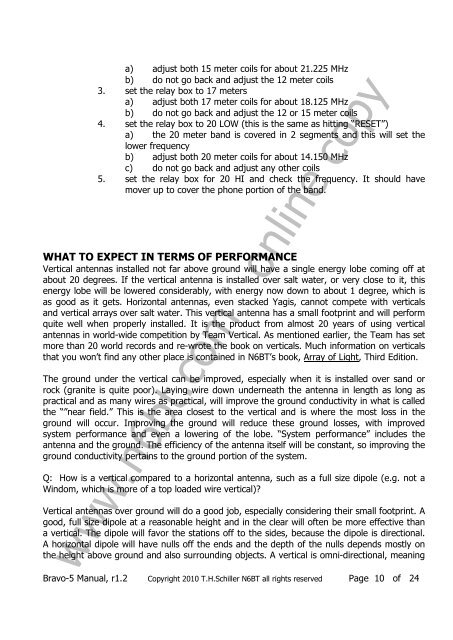You also want an ePaper? Increase the reach of your titles
YUMPU automatically turns print PDFs into web optimized ePapers that Google loves.
a) adjust both 15 meter coils for about 21.225 MHz<br />
b) do not go back and adjust the 12 meter coils<br />
3. set the relay box to 17 meters<br />
a) adjust both 17 meter coils for about 18.125 MHz<br />
b) do not go back and adjust the 12 or 15 meter coils<br />
4. set the relay box to 20 LOW (this is the same as hitting “RESET”)<br />
a) the 20 meter band is covered in 2 segments and this will set the<br />
lower frequency<br />
b) adjust both 20 meter coils for about 14.150 MHz<br />
c) do not go back and adjust any other coils<br />
5. set the relay box for 20 HI and check the frequency. It should have<br />
mover up to cover the phone portion of the band.<br />
WHAT TO EXPECT IN TERMS OF PERFORMANCE<br />
Vertical antennas installed not far above ground will have a single energy lobe <strong>com</strong>ing off at<br />
about 20 degrees. If the vertical antenna is installed over salt water, or very close to it, this<br />
energy lobe will be lowered considerably, with energy now down to about 1 degree, which is<br />
as good as it gets. Horizontal antennas, even stacked Yagis, cannot <strong>com</strong>pete with verticals<br />
and vertical arrays over salt water. This vertical antenna has a small footprint and will perform<br />
quite well when properly installed. It is the product from almost 20 years of using vertical<br />
antennas in world-wide <strong>com</strong>petition by Team Vertical. As mentioned earlier, the Team has set<br />
more than 20 world records and re-wrote the book on verticals. Much information on verticals<br />
that you won’t find any other place is contained in N6BT’s book, Array of Light, Third Edition.<br />
The ground under the vertical can be improved, especially when it is installed over sand or<br />
rock (granite is quite poor). Laying wire down underneath the antenna in length as long as<br />
practical and as many wires as practical, will improve the ground conductivity in what is called<br />
the “”near field.” This is the area closest to the vertical and is where the most loss in the<br />
ground will occur. Improving the ground will reduce these ground losses, with improved<br />
system performance and even a lowering of the lobe. “System performance” includes the<br />
antenna and the ground. The efficiency of the antenna itself will be constant, so improving the<br />
ground conductivity pertains to the ground portion of the system.<br />
Q: How is a vertical <strong>com</strong>pared to a horizontal antenna, such as a full size dipole (e.g. not a<br />
Windom, which is more of a top loaded wire vertical)?<br />
Vertical antennas over ground will do a good job, especially considering their small footprint. A<br />
good, full size dipole at a reasonable height and in the clear will often be more effective than<br />
a vertical. The dipole will favor the stations off to the sides, because the dipole is directional.<br />
A horizontal dipole will have nulls off the ends and the depth of the nulls depends mostly on<br />
the height above ground and also surrounding objects. A vertical is omni-directional, meaning<br />
<strong>www</strong>.<strong>n6bt</strong>.<strong>com</strong> <strong>online</strong> <strong>copy</strong><br />
Bravo-5 Manual, r1.2 Copyright 2010 T.H.Schiller N6BT all rights reserved Page 10 of 24




